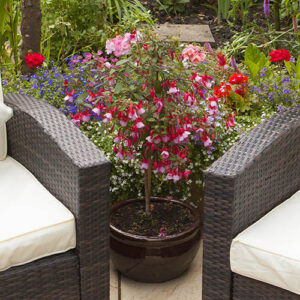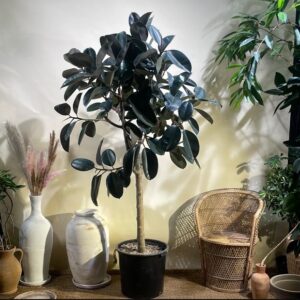Description
Norfolk Island Pine – 1 Yr Old Seedling
Overview
The Norfolk Island Pine (Araucaria heterophylla) is an elegant indoor tree with soft, feathery needles that create a tropical, lush atmosphere. Though not a true pine, its symmetrical, layered branches make it a popular ornamental plant for homes and offices. This slow-growing tree is easy to care for and adds a unique and serene touch to indoor spaces. With its graceful shape, the Norfolk Island Pine is perfect for those looking to bring a touch of the tropics into their home.
Native Range
Native to Norfolk Island in the South Pacific, the Norfolk Island Pine thrives in coastal tropical climates but is well-suited to indoor environments.
Growth and Form
- Height: Grows 6–12 inches annually, reaching up to 3–5 feet indoors at maturity.
- Spread: Typically 2–3 feet wide at maturity.
- Growth Rate: Slow growth, making it suitable for small indoor spaces.
- Foliage: Soft, feathery needles that form dense layers along the branches, offering a lush and tropical appearance.
- Bark: Smooth, light-colored bark that adds to the tree’s clean, elegant look.
Ecological Benefits
- Air Purification: Known for its ability to improve indoor air quality by filtering out toxins.
- Low Maintenance: Ideal for people seeking a low-care yet visually stunning plant for their home or office.
Hardiness and Climate Tolerance
- Hardiness Zones: 10–11 (Best suited for indoor environments).
- Temperature Tolerance: Prefers temperatures between 60–75°F (16–24°C), but can tolerate occasional dips to 50°F (10°C).
- Humidity: Prefers moderate humidity levels, making it suitable for bathrooms or kitchens.
- Light Preferences: Thrives in bright, indirect light but can tolerate lower light levels.
Planting and Care
- Planting Location: Place in bright, indirect light. Avoid direct sunlight, which can scorch the soft needles.
- Watering: Water when the top inch of soil feels dry. Be careful not to overwater, as the tree prefers well-drained soil.
- Fertilization: Feed with a balanced fertilizer every 4–6 weeks during the growing season (spring and summer).
- Pruning: Minimal pruning is needed. Remove any dead or damaged branches to maintain the tree’s shape.
Uses
- Ornamental: Adds a touch of tropical elegance to homes, offices, and holiday decorations.
- Decorative Tree: Popular as a small Christmas tree or holiday centerpiece due to its symmetrical shape and unique appearance.
Potential Problems
- Overwatering: Can cause root rot. Ensure the soil has proper drainage to avoid standing water.
- Pests and Diseases: May be prone to scale or aphids. Regularly inspect the tree for pests and treat as necessary.
- Low Light: Prolonged exposure to low light can lead to sparse growth and poor needle health.






Reviews
There are no reviews yet.